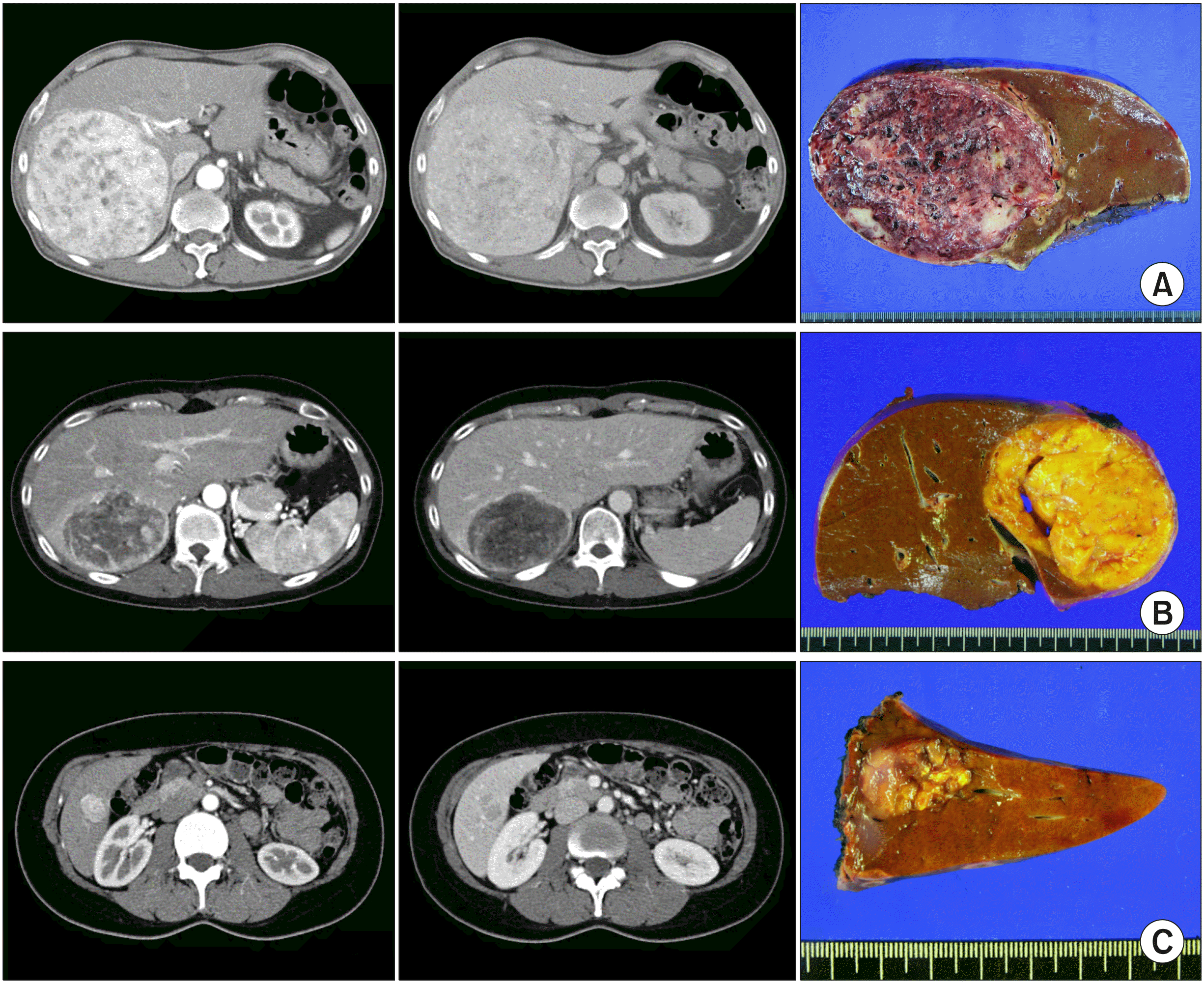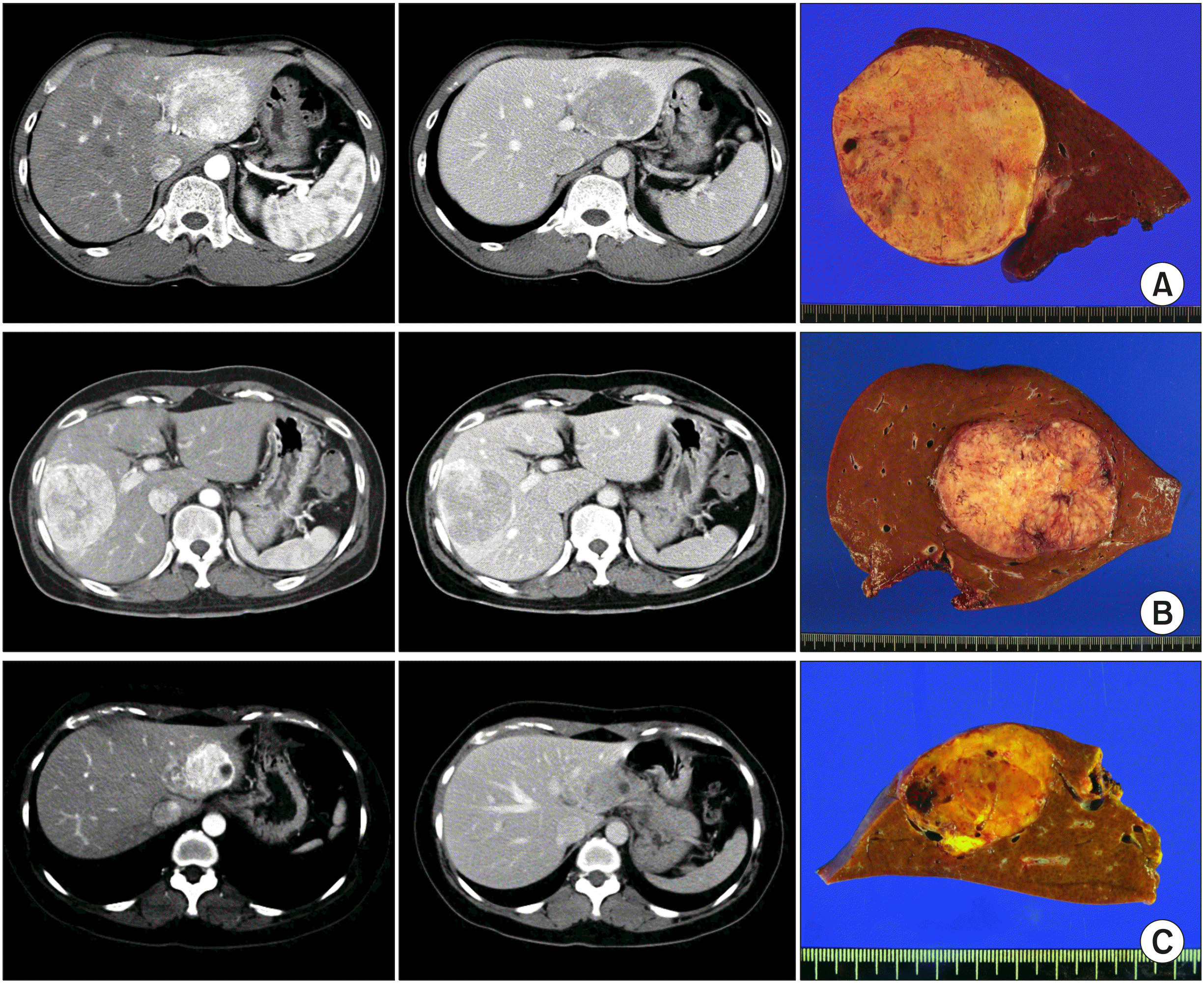2. Ameurtesse H, Chbani L, Bennani A, Toughrai I, Beggui N, Kamaoui I, et al. 2014; Primary perivascular epithelioid cell tumor of the liver: new case report and literature review. Diagn Pathol. 9:149. DOI:
10.1186/1746-1596-9-149. PMID:
25034830. PMCID:
PMC4223599.

3. Ortiz S, Tortosa F. 2016; Epithelioid angiomyolipoma of the liver: clinicopathological correlation in a series of 4 cases. Rev Esp Enferm Dig. 108:27–30. DOI:
10.17235/reed.2015.3947/2015. PMID:
26765232.

4. Chang Z, Zhang JM, Ying JQ, Ge YP. 2011; Characteristics and treatment strategy of hepatic angiomyolipoma: a series of 94 patients collected from four institutions. J Gastrointestin Liver Dis. 20:65–69.
5. Shi H, Cao D, Wei L, Sun L, Guo A. 2010; Inflammatory angiomyolipomas of the liver: a clinicopathologic and immunohistochemical analysis of 5 cases. Ann Diagn Pathol. 14:240–246. DOI:
10.1016/j.anndiagpath.2010.03.002. PMID:
20637427.

6. Jung DH, Hwang S, Hong SM, Kim KH, Ahn CS, Moon DB, et al. 2018; Clinico-pathological correlation of hepatic angiomyolipoma: a series of 23 resection cases. ANZ J Surg. 88:E60–E65. DOI:
10.1111/ans.13880. PMID:
28122404.

7. Lencioni R. 2010; Surveillance and early diagnosis of hepatocellular carcinoma. Dig Liver Dis. 42 Suppl 3:S223–S227. DOI:
10.1016/S1590-8658(10)60509-9.

8. Cho HD, Hwang S, Lee YJ, Park KM, Kim KH, Kim JC, et al. 2016; Changes in the types of liver diseases requiring hepatic resection: a single-institution experience of 9016 cases over a 10-year period. Korean J Hepatobiliary Pancreat Surg. 20:49–52. DOI:
10.14701/kjhbps.2016.20.2.49. PMID:
27212990. PMCID:
PMC4874044.

9. Hwang S, Ha TY, Song GW, Jung DH, Ahn CS, Moon DB, et al. 2015; Quantified risk assessment for major hepatectomy via the indocyanine green clearance rate and liver volumetry combined with standard liver volume. J Gastrointest Surg. 19:1305–1314. DOI:
10.1007/s11605-015-2846-8. PMID:
25947549.

10. Lee SG, Hwang S. 2005; How I do it: assessment of hepatic functional reserve for indication of hepatic resection. J Hepatobiliary Pancreat Surg. 12:38–43. DOI:
10.1007/s00534-004-0949-9. PMID:
15754098.

11. Hwang S, Lee YJ, Kim KH, Ahn CS, Moon DB, Ha TY, et al. 2015; The impact of tumor size on long-term survival outcomes after resection of solitary hepatocellular carcinoma: single-institution experience with 2558 patients. J Gastrointest Surg. 19:1281–1290. DOI:
10.1007/s11605-015-2849-5. PMID:
25956724.

12. Hwang S, Lee YJ, Song GW, Park KM, Kim KH, Ahn CS, et al. 2015; Prognostic impact of tumor growth type on 7th AJCC staging system for intrahepatic cholangiocarcinoma: a single-center experience of 659 cases. J Gastrointest Surg. 19:1291–1304. DOI:
10.1007/s11605-015-2803-6. PMID:
25820487.

13. Yoon YI, Hwang S, Lee YJ, Kim KH, Ahn CS, Moon DB, et al. 2016; Postresection outcomes of combined hepatocellular carcinoma-cholangiocarcinoma, hepatocellular carcinoma and intrahepatic cholangiocarcinoma. J Gastrointest Surg. 20:411–420. DOI:
10.1007/s11605-015-3045-3. PMID:
26628072.

14. Miettinen M, Fletcher CD, Kindblom LG, Zimmermann A, Tsui WMS. Bosman FT, Carneiro F, Hruban RH, Theise ND, editors. 2010. Mesenchymal tumours of the liver. WHO classification of tumours of the digestive system. 4th ed. International Agency for Research on Cancer;Lyon: p. 241–250.
16. Tryggvason G, Blöndal S, Goldin RD, Albrechtsen J, Björnsson J, Jónasson JG. 2004; Epithelioid angiomyolipoma of the liver: case report and review of the literature. APMIS. 112:612–616. DOI:
10.1111/j.1600-0463.2004.apm1120909.x. PMID:
15601311.

17. Xu PJ, Shan Y, Yan FH, Ji Y, Ding Y, Zhou ML. 2009; Epithelioid angiomyolipoma of the liver: cross-sectional imaging findings of 10 immunohistochemically-verified cases. World J Gastroenterol. 15:4576–4581. DOI:
10.3748/wjg.15.4576. PMID:
19777618. PMCID:
PMC2752004.

18. Xiao W, Zhou M, Lou H, Wang Z, Zhang M. 2010; Hemodynamic characterization of hepatic angiomyolipoma with least amount of fat evaluated by contrast-enhanced magnetic resonance angiography. Abdom Imaging. 35:203–207. DOI:
10.1007/s00261-009-9508-9. PMID:
19319591.

19. Agaimy A, Vassos N, Croner RS, Strobel D, Lell M. 2012; Hepatic angiomyolipoma: a series of six cases with emphasis on pathological-radiological correlations and unusual variants diagnosed by core needle biopsy. Int J Clin Exp Pathol. 5:512–521.
20. Bleeker JS, Quevedo JF, Folpe AL. 2012; "Malignant" perivascular epithelioid cell neoplasm: risk stratification and treatment strategies. Sarcoma. 2012:541626. DOI:
10.1155/2012/541626. PMID:
22619565. PMCID:
PMC3350998.

21. Mizuguchi T, Katsuramaki T, Nobuoka T, Nishikage A, Oshima H, Kawasaki H, et al. 2004; Growth of hepatic angiomyolipoma indicating malignant potential. J Gastroenterol Hepatol. 19:1328–1330. DOI:
10.1111/j.1440-1746.2004.03583.x. PMID:
15482547.

22. Deng YF, Lin Q, Zhang SH, Ling YM, He JK, Chen XF. 2008; Malignant angiomyolipoma in the liver: a case report with pathological and molecular analysis. Pathol Res Pract. 204:911–918. DOI:
10.1016/j.prp.2008.06.007. PMID:
18723294.

23. Wang WT, Li ZQ, Zhang GH, Guo Y, Teng MJ. 2015; Liver transplantation for recurrent posthepatectomy malignant hepatic angiomyolipoma: a case report. World J Gastroenterol. 21:3755–3758. DOI:
10.3748/wjg.v21.i12.3755. PMID:
25834347. PMCID:
PMC4375604.

24. Fukuda Y, Omiya H, Takami K, Mori K, Kodama Y, Mano M, et al. 2016; Malignant hepatic epithelioid angiomyolipoma with recurrence in the lung 7 years after hepatectomy: a case report and literature review. Surg Case Rep. 2:31. DOI:
10.1186/s40792-016-0158-1. PMID:
27037804. PMCID:
PMC4818648.

25. Occhionorelli S, Dellachiesa L, Stano R, Cappellari L, Tartarini D, Severi S, et al. 2013; Spontaneous rupture of a hepatic epithelioid angiomyolipoma: damage control surgery. A case report. G Chir. 34:320–322.
26. Brimo F, Robinson B, Guo C, Zhou M, Latour M, Epstein JI. 2010; Renal epithelioid angiomyolipoma with atypia: a series of 40 cases with emphasis on clinicopathologic prognostic indicators of malignancy. Am J Surg Pathol. 34:715–722. DOI:
10.1097/PAS.0b013e3181d90370. PMID:
20410812.







 PDF
PDF Citation
Citation Print
Print



 XML Download
XML Download